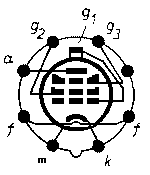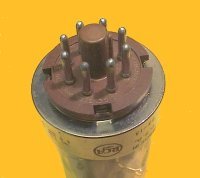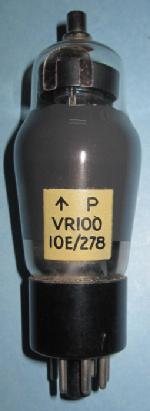
VR100
|
|
|||||||||||||||||||||||||||||||
|
Hits: 5694 Replies: 12
VR100 (VR100)
|
|
|
Bo Samuelsson
15.Jan.07 |
1
Hi! I am interested in the valves VR18, VR21, VR22, VR27 and VU33 which are used in the GB aircraft receiver R1082 and the VR99, VR100, VR101,VR102 , VI103 and VR99A used in the R1155. I have both receivers in my collection and also some spare valves. When looking at these valves in RMorg I find some confusion with equivalency among valves numbered in the different numbering systems. I have compiled a list which I would like our GB experts to confirm, complete and critizise!! After that I hope the valve admins will complete the listings and I have pictures, measures and pin assignments to add. In 1941 the GB military services started to use the CV numbering system, common to the Army, Navy and Air Force. Before that the Army used the first letter A, the Navy used N and the Air Force V, with the second letter R for receiver, T for transmitter, I for indicator valves and so on. In RMorg many of these valves are filed under the 10E numbering system which was the Air Ministry storage ref. no. and in my opinion not really a valve designation (although it was printed on some valves) and no pointers are showing the equivalents in the A, N, V and CV systems. The following list is compiled from data in the CV Register of Electronic Valves Dec 1944 and from the Virtual Valve Museum data (Jeremy M. Harmer): VR18=CV1018=10E/7607 VR21=CV1021=10E/7738 VR22=CV1022=10/E7958 VR27=CV1027=10E/8239 VU33=CV1033=10E/9829 VR99=CV1099=10E277 VR100=CV1100=NR64=10E/278 VR101=CV1101=10E/280=MHLD6 VR102=CV1102=10E/279=BL63? VI103=CV1103=NR69=10E/305=Y63 VR99A=CV1581=10E/757 I suppose it is not possible to get a complete cross reference list but at least we can make it for these valves! Regards Bo S. |
|
Roy Johnson
15.Jan.07 |
2
Dear Bo, I have as complete a list as is possible for the earlier types and am slowly introducing them into the system. (You will have seen my note to you re your Vi103). I have witten a paper with fuller details of the complete system and hope to post this soon when finalised. The short answer is that the lists need to be read with caution. In particular remember that CV is in general, a specification for a tube NOT a valve type! Sometimes the specification was issued first, sometimes a designation was given to an existing proven tube. In the meantime, please do not hestitate to ask and I shall let you have all information. Kind regards, Roy I
|
|
John Turrill
15.Jan.07 |
3
You should find most of these valves listed in RMorg, along
with their equivalents;- regarding the VU33, this was, I think
used across the aerial input of at least one British airborne
radio, presumably to minimise bursts of static?
It seems to have been, at least in some cases, a triode with
anode and grid strapped together.
I have already submitted phots etc. for the following -
VR99 (X66), VR100 (KTW62), VR101 (MHLD6)
For now, -
Air force | Commercial
VR18 = 215SG
VR21 = 210LF
VR22 = 220PA
VR27 = 210LF
VU33 = ? see link
VR99 = X66
VR100 = KTW62
VR101 = MHLD6
VR102 = BL63
VI103 = Y63
VR99A = ECH35
Regards,
John Turrill.
|
|
Bo Samuelsson
15.Jan.07 |
4
Hello Roy Thanks for your quick answer. Sorry, I have not seen any note from you re my Vi103. My pictures for the Vi103 were added to the stores ref no 10E/305 and not to the Vi103 which puzzels me. There is no cross reference between the 10E/305 and the Vi103 nor to the CV1103, and if I was looking for this valve I would definitely search for Vi103 which is the designation on the R1155 schematics. I am happy to hear you have complete listings and will add cross references, why not start with the valves I listed? ;-) Best regards Bo |
|
Bo Samuelsson
15.Jan.07 |
5
Hi John, Yes, you are quite right, the VU33 was used in my R1082 as a limiter across the antenna input to limit too strong input signals. Apparently the receiver was not switched off when transmitting, but used in a "listen through" mode, so the need for the limiter is obvious. The valve is missing in my receiver which does not impair its function, according to the manual the valves were often leeky and then dampened the input signal. Yes, I have found most of the valves in RMorg but with very little data and under different designations and with very few cross references, so I think we have to make a joint effort to make the list better! Regards Bo |
|
Roy Johnson
15.Jan.07 |
6
Dear Bo and John, Yes, I am slowly working my way along the CV list - now up to about CV260. So there is a long way to go as I like to follow the precedents and following valves along with any civilian models from the original manufacturers' data sheets rather than just listing CV numbers without data or possibly wrong data from some of the equivalents lists. I shall certainly sort out the Vi103 area soon. Note that it IS Vi103 not VI103. This was the official name to avoid confusion between I and 1. This means that VI103 will be locked off. Then I am happy to add in Bo's list. Thanks for the suggestions, please keep them coming! Kind regards to all, Roy |
|
Hans-Thomas Schmidt
16.Jan.07 |
7
Dear Sirs, I know two large lists about equivalents of the Common Valves: Both are from B. Babani. 1. Babani, International radio tube encyclopedia, 3rd and last edition 1958 and 2. Handbook of radio TV, Industrial and Tarnsmitting Tube and Valve Equivalents, 1974, CV numbers up to 10000. Today, the CV numbers are continued in the NATO stock number. In the both named books, there are also British military valves and their equivalents listed. Best regards, H.-T. Schmidt |
|
Roy Johnson
16.Jan.07 |
8
Yes, these are quite useful and are generally reasonably accurate. They are based on the CV Register of Electronic Valves Issued by the Tecnical Valve Committee of the Joint Electronics Standardisation Committe initially part of the Ministry of Supply of the UK Government. This contains both the old style descriptions and the CV list. These A4 lists were updated regularly both manually with notes, cut-and-paste and by additional pages. The Column heading next to the Tube is "Prototypes and Possible Substitutes" and it is here where one has to be careful! The "possible substitutes" are often not "Equivalents" in the way that we now interpret it. They are designed for practical use sometimes in the field and remote places! Luckily, I was part of that UK Government during the "Valve Era" so I have been able to keep some of the older documents - now coming in very useful! I shall gradually work through the lists but need to cross-check at each stage detail of the types given, normally against the manufacturers data. I also propose that we have a category "Other Name For". This will distinguish between VR99 CV1099 and 10E/277 being just the SAME and valves of the same specification in all respects "Equivalent". In the meantime if there are any doubts or queries on the CVs, I am delighted to look up. With kind regards to all, Roy |
|
Jeremy Harmer
16.Jan.07 |
9
Regarding CV valves, as well as the 1944, 1946 and 1963 (final) CV Registers on my website (http://www.tubecollector.org) I also have a lot of actual CV specification data - the EVS data - which I am slowly (!) scanning. As to Babani I find their data, and even the AVO data, is sometimes wrong. The CV Registers are the authority, but you often need to check all three of them! I also have a 'quick and dirty' CV lookup here: http://tubecollector.org/cv/cv.php - but the data is not that good! Jeremy. |
|
John Carter
16.Jan.07 |
10
Hi, Can I just add a a few words to this. Care must be taken with using 10E/ numbers as a reference. These numbers are stores reference numbers, like ordering from a mail order catalogue. I know from my RAF service that some individual items had a stores number, but that if packed in a box of ten, that box could have a different number. I do not know however if this applies to valves. I would also point out that care should be taken with U. S. Signal Corps valves as they had a prefix of VT and just to add to the confusion, the old G.P.O. in Britain also used a prefix of VT for all of their valves, before changing to CV numbers. The Radio Society of Great Britain has published books over the years and are a great reference for CV and military etc., cross reference. www.rsgb.org Regards to all, John C. |
|
Roy Johnson
16.Jan.07 |
11
Dear Jeremy, John and All, You are absolutely right! That is why there are many errors in the literature including Babani! I was of two minds about even including 10E and other stores reference types as Valve types. However a large number have been entered and it may be preferable to lock these off with a reference to the actual CV where it exists. Yes, John, 10E nubers referred to all sorts of things! The numbers sometimes referred to the packing box and if you got one digit wrong you had a tank delivered! Luckily the official documentation is usually, but not always correct and differentiation with PO USA and UK VT types is made clear unlike some of the third party books. My collection of EVS data is far from complete. There was a tendency to throw away the data fo obsolete valves and I should like to know, Jeremy if you have anything like a complete set. It would be great to be able to complete the total EVS set issued! If anyone else has them, we could see what we jointly have. I know of no published set at the moment, but have made an enquiry at NLL. Kind regards to all Roy |
|
Bo Samuelsson
19.Jan.07 |
12
Many thanks to Roy for updating the references for the valves on my list!! Best regards Bo S. |
|
Jeremy Harmer
24.Jan.07 |
13
Making a full set of EVS sheets would be great. I have a lot, but there are a lot missing too. As I said I am slowly scanning these in but the oldest sheets do not go through our sheet-feeder very well. If we each make a list of the ranges we have we can compare. My set does not have any of the later semiconductor data (e.g. CV7000 onwards), and there are some annoying ommissions from the early stuff too. Jeremy. |
End of forum contributions about this tube
| Data Compliance | More Information |



